Monthly Archives: March 2022

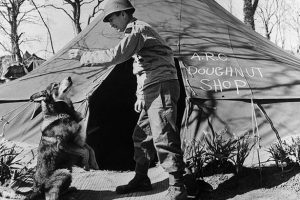 As most of us know, dogs have been used in many kinds of work from K-9 units to military units to guide dogs, to cadaver dogs, and many more. During World War II, one such dog named Chips, who was a Shepherd-Collie-Husky mix, served for 3.5 years of the war. When the US entered World War II, the military actually asked Americans to “donate” their dogs to serve on patrols and guard duty. That seems so strange to me. How could the dog know what was going on? How could it not get depressed or aggressive, thinking its owner was dead or had abandoned it? It’s one thing to send a soldier into a war situation, they have either been legally drafted or they freely joined up, but a dog…or any animal for that matter, couldn’t possibly understand why, after having a family of their own, they were suddenly in a foreign country, without their owner, their own bed, or their home.
As most of us know, dogs have been used in many kinds of work from K-9 units to military units to guide dogs, to cadaver dogs, and many more. During World War II, one such dog named Chips, who was a Shepherd-Collie-Husky mix, served for 3.5 years of the war. When the US entered World War II, the military actually asked Americans to “donate” their dogs to serve on patrols and guard duty. That seems so strange to me. How could the dog know what was going on? How could it not get depressed or aggressive, thinking its owner was dead or had abandoned it? It’s one thing to send a soldier into a war situation, they have either been legally drafted or they freely joined up, but a dog…or any animal for that matter, couldn’t possibly understand why, after having a family of their own, they were suddenly in a foreign country, without their owner, their own bed, or their home.
Nevertheless, when their country asked, over 11,000 Americans volunteered their pets, including Chips’s owner, John Wren of Pleasantville, New York. Chips the first “volunteer” dog in the United States, took part in the invasion of Sicily, just a year into his deployment. When an Italian machine gunner pinned down Chips and his squad, he broke away from his leash and charged into the enemy position. A single shot rang out. Then, the Italian gunner emerged with Chips at his throat, followed by three more soldiers. They all quickly surrendered. Chips received a wound on his scalp and burns on his mouth and left eye. That didn’t stop this hero dog, who kept fighting and helped capture 10 more soldiers that day.
After the war, per their request, it was time for Chips to be returned to his family. Plans would have to be put in place for that to happen. So, in the fall of 1945 he was taken back to Front Royal where he was retrained so that he could go back to his family. A dog who had been in combat couldn’t just go back to his family as if nothing had happened. Finally in December of 1945, he traveled home to Pleasantville, riding in the baggage car of a train. He didn’t go alone. He was accompanied by six reporters and photographers who wanted to 
 cover the story. They were met by Mr and Mrs Wren and their son, Johnny, who was only a baby when Chips left. The girls raced home after school to see their dog. It was a sweet homecoming. Chips lived for just four months before his kidneys failed. I guess war had taken its toll.
cover the story. They were met by Mr and Mrs Wren and their son, Johnny, who was only a baby when Chips left. The girls raced home after school to see their dog. It was a sweet homecoming. Chips lived for just four months before his kidneys failed. I guess war had taken its toll.
Chips’s story made him an international sensation. He received a Silver Star for his heroics. Unfortunately, some people thought that a dog shouldn’t be awarded the same medal as a human, so it was revoked. Then, in 2018, he was awarded the PDSA Dickin Award, the highest honor for wartime bravery for an animal. A well-deserved honor. While his award was amazing, I think that the family should have also received an award, as should all of the other families who donated their dogs for the war effort. It was a very selfless act.

 The day after the debut of the Barbi doll on March 9, 1959, at the American Toy Fair in New York City, the doll had become an instant sensation. Basically, her debut makes Barbie 63 years old. The old girl has aged very well. In fact, she hasn’t aged a bit, although she can’t say she hasn’t had any work done. The reality is that Barbie has been redesigned at least every year. Of course, that isn’t saying she has had plastic surgery…or is it? She is, after all, made of plastic.
The day after the debut of the Barbi doll on March 9, 1959, at the American Toy Fair in New York City, the doll had become an instant sensation. Basically, her debut makes Barbie 63 years old. The old girl has aged very well. In fact, she hasn’t aged a bit, although she can’t say she hasn’t had any work done. The reality is that Barbie has been redesigned at least every year. Of course, that isn’t saying she has had plastic surgery…or is it? She is, after all, made of plastic.
Barbie stands eleven inches tall, and at first anyway, had long blond hair. These days, of course as hairstyles have changed and it was decided that not all girls are blonds, her hair color and style have changed with the times. She has been given lots of cool clothes, shoes, a house, car, RV, and boat…and probably many other things. Barbie was the first mass-produced toy doll in the United States with adult features. I suppose that she caused quite a stir with many parents, but for girls everywhere, she was the princess they were going to be when they grew up. I know I couldn’t wait to get one.
The woman behind Barbie was Ruth Handler, who co-founded Mattel, Inc with her husband in 1945. Handler witnessed her young daughter ignore her baby dolls to play make-believe with paper dolls of adult women, at which point she realized there was an important niche in the market for a toy that allowed little girls to imagine the future. Barbie’s appearance was modeled on a doll named Lilli, based on a German comic strip character. Lilli was originally marketed as a racy gag gift to adult men in tobacco shops, but she later became extremely popular with children. Mattel bought the rights to Lilli and made its own version, which Handler named after her daughter, Barbara.
In 1955, Mattel became a sponsor of the “Mickey Mouse Club” TV program. With that, Mattel became one of the first toy companies to broadcast commercials aimed specifically at children. They used their commercials to promote their new toy, and by 1961, the enormous consumer demand for the doll led Mattel to release a boyfriend for Barbie. Handler named him Ken, after her son. Then, Barbie’s best friend, Midge, came out in 1963; her little sister, Skipper, debuted in 1964.
Of course, the Barbie doll was not without controversy. On a positive note, many women saw Barbie as providing an alternative to traditional 1950s gender roles. Her many careers, like airline stewardess, doctor, pilot, astronaut, Olympic athlete, and even US presidential candidate made some women see a possible future that was different 
 than was common in the 1950s. Others thought Barbie’s never-ending supply of designer outfits, cars, and “Dream Houses” encouraged kids to be materialistic. However, the biggest controversy was over Barbie’s appearance. Her figure was unrealistic for a real woman. It was estimated that if she were a real woman, her measurements would be 36-18-38–led many to claim that Barbie provided little girls with an unrealistic and harmful example and fostered negative body image. Nevertheless, even with the criticism, Barbie never lost her appeal, and in fact she is as popular today as she ever was. I was just 3 years old when Barbie came out, and today, my great granddaughter, Cambree Petersen loves her Barbie dolls as much as I did, even if Barbie is…old!!!
than was common in the 1950s. Others thought Barbie’s never-ending supply of designer outfits, cars, and “Dream Houses” encouraged kids to be materialistic. However, the biggest controversy was over Barbie’s appearance. Her figure was unrealistic for a real woman. It was estimated that if she were a real woman, her measurements would be 36-18-38–led many to claim that Barbie provided little girls with an unrealistic and harmful example and fostered negative body image. Nevertheless, even with the criticism, Barbie never lost her appeal, and in fact she is as popular today as she ever was. I was just 3 years old when Barbie came out, and today, my great granddaughter, Cambree Petersen loves her Barbie dolls as much as I did, even if Barbie is…old!!!

 My grandniece, Manuela Ortiz (Renville) is a sweet girl, who is full of life and joy. She married my grandnephew, James Renville last summer, and they have been enjoying their new life together. They both love to travel, and they go as much as they can. I think their favorite places will most likely always include beaches. Manuela, or Manu, as she is lovingly called by all who know her well, immigrated to the United States from Medellín, Antioquia, Columbia, and so she is used to the warm equatorial climate, making the warm beaches feel a lot like home. Still, she has adapted well to the cold northern climate too. Manuela and James love to go skiing and play in the snow, something Manuela probably never saw, until he moved here. They are open to all kinds of climates and will find a way to have fun anywhere.
My grandniece, Manuela Ortiz (Renville) is a sweet girl, who is full of life and joy. She married my grandnephew, James Renville last summer, and they have been enjoying their new life together. They both love to travel, and they go as much as they can. I think their favorite places will most likely always include beaches. Manuela, or Manu, as she is lovingly called by all who know her well, immigrated to the United States from Medellín, Antioquia, Columbia, and so she is used to the warm equatorial climate, making the warm beaches feel a lot like home. Still, she has adapted well to the cold northern climate too. Manuela and James love to go skiing and play in the snow, something Manuela probably never saw, until he moved here. They are open to all kinds of climates and will find a way to have fun anywhere.
Manuela has a bubbly personality and makes life fun for anyone who knows her. She has been such a wonderful blessing to my niece Toni Chase and her husband, Dave. For most of his life, James has been their only child, 
 and now they have been given a daughter (daughter-in-law, but they don’t think of her as just a daughter-in-law) to complete their family…until grandbabies can come along…someday, hehehe. I think that whenever James and Manuela decide to have children, they will make beautiful babies, and I can’t wait to see them. Manuela has been so good for James, because he has a more reserved personality, but she brings out the other side of him, the side he only shows to those he knows well. When they are ready to have children, they will be a beautiful mix of both of them.
and now they have been given a daughter (daughter-in-law, but they don’t think of her as just a daughter-in-law) to complete their family…until grandbabies can come along…someday, hehehe. I think that whenever James and Manuela decide to have children, they will make beautiful babies, and I can’t wait to see them. Manuela has been so good for James, because he has a more reserved personality, but she brings out the other side of him, the side he only shows to those he knows well. When they are ready to have children, they will be a beautiful mix of both of them.
Manuela loves to dance, and coming from Columbia, she knows all the cool dances of that area. Dances like the Salsa, and many others that I would not know the names of, come as naturally to Manuela as walking, because she comes from a culture where these things are a part of everyday life. In fact, it is really fun to watch her dance, because she is so good at it. James can dance, but like most of us in this family, it is not something we do every day, so Manuela has been teaching him these dances, and he is getting very good as well. I’m sure 
 that comes as part natural ability and part having a great teacher. James is such a good man, and I know that whether he is a natural at dancing or not, Manuela’s family loves him just because he is who he is…as good a husband to Manuela and she is a wife to him. Speaking of teaching, this happens to be one of Manuela’s many talents! She is also teaching James Spanish and loves to make tic-toc videos to share his progress. They are pretty funny to watch. She also teaches English on-line to private students. She is a great teacher! She is a podcaster in her free time on YouTube at Con Manu en la sala and a Tik-Tok @manuejames. As they go through their lives, I know that they will continue to be a blessing to each other and to their families. Today is Manuela’s birthday. Happy birthday Manuela!! Have a great day!! We love you!!
that comes as part natural ability and part having a great teacher. James is such a good man, and I know that whether he is a natural at dancing or not, Manuela’s family loves him just because he is who he is…as good a husband to Manuela and she is a wife to him. Speaking of teaching, this happens to be one of Manuela’s many talents! She is also teaching James Spanish and loves to make tic-toc videos to share his progress. They are pretty funny to watch. She also teaches English on-line to private students. She is a great teacher! She is a podcaster in her free time on YouTube at Con Manu en la sala and a Tik-Tok @manuejames. As they go through their lives, I know that they will continue to be a blessing to each other and to their families. Today is Manuela’s birthday. Happy birthday Manuela!! Have a great day!! We love you!!
 How can the February Revolution begin on March 8th, you might ask? Well, if you know much about 1917 Russia, you know that the calendar at that time was the Julian calendar, and not the Gregorian calendar that we use today in most countries. That was how the February Revolution (known as such because of Russia’s use of the Julian calendar) which began on February 23rd in the Julian calendar, actually began on March 8th in the now-used Gregorian calendar. The February Revolution started with riots and strikes over the scarcity of food erupt in Petrograd. One week later, centuries of czarist rule in Russia ended with the abdication of Czar Nicholas II, and Russia took a dramatic step closer to a communist revolution.
How can the February Revolution begin on March 8th, you might ask? Well, if you know much about 1917 Russia, you know that the calendar at that time was the Julian calendar, and not the Gregorian calendar that we use today in most countries. That was how the February Revolution (known as such because of Russia’s use of the Julian calendar) which began on February 23rd in the Julian calendar, actually began on March 8th in the now-used Gregorian calendar. The February Revolution started with riots and strikes over the scarcity of food erupt in Petrograd. One week later, centuries of czarist rule in Russia ended with the abdication of Czar Nicholas II, and Russia took a dramatic step closer to a communist revolution.
By 1917, Czar Nicholas II had already lost all of his credibility. The corruption in the government was rampant, the economy was a mess, and Nicholas repeatedly dissolved the Duma…the Russian parliament established after the Revolution of 1905…whenever it opposed his will. All that was bad, but the immediate cause of the February Revolution, which was the first phase of the Russian Revolution of 1917…was Russia’s disastrous involvement in World War I. Militarily, Russia was no match for industrialized Germany, and Russian casualties were greater than those sustained by any nation in any previous war. They were severely pounded by the Germans. Meanwhile, the economy was hopelessly disrupted by the costly war effort, and moderates joined Russian radical elements in calling for the overthrow of the czar, who was already weak due to family problems, namely a sick child.
While most of the world switched from the Julian calendar to the Gregorian calendar in 1582, Russia didn’t make the conversion until 1918. So, 104 years ago, the Russian people irrevocably had half a month wiped out of their lives…13 days of February in 1918. Their calendar went from January 31, 1918, to February 14, 1918…overnight. On March 8th or February 23rd, 1917, depending on the calendar you choose to use for the event, demonstrators were clamoring for bread in the streets of the Russian capital of Petrograd (now known as Saint Petersburg). Supported by 90,000 men and women on strike, the protesters clashed with police but refused to leave the streets. The strike spread, and on March 10th, it had spread among all of Petrograd’s workers, and irate mobs of workers destroyed police stations. Several factories elected deputies to the Petrograd Soviet, or “council” of workers’ committees, following the model devised during the Revolution of 1905.
By March 11th, the troops of the Petrograd army garrison ordered soldiers to crush the uprising. Regiments opened fire, killing demonstrators, but the protesters kept to the streets, and the troops began to waver. Nicholas dissolved the Duma again on that day, and on March 12, the revolution triumphed when regiment after regiment of the Petrograd garrison defected to the cause of the demonstrators. The soldiers, some 150,000 men, subsequently formed committees that elected deputies to the Petrograd Soviet.
The uprising forced the imperial government to resign, and the Duma formed a provisional government that peacefully vied with the Petrograd Soviet for control of the revolution. March 14th, saw the Petrograd Soviet 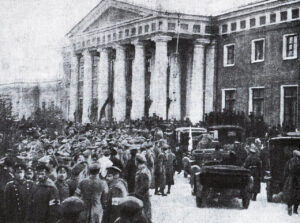 issuing “Order No. 1,” which instructed Russian soldiers and sailors to obey only those orders that did not conflict with the directives of the Soviet. Czar Nicholas II abdicated the throne the next day, March 15th, in favor of his brother Michael, who refused the crown, ending the czarist autocracy.
issuing “Order No. 1,” which instructed Russian soldiers and sailors to obey only those orders that did not conflict with the directives of the Soviet. Czar Nicholas II abdicated the throne the next day, March 15th, in favor of his brother Michael, who refused the crown, ending the czarist autocracy.
The Petrograd Soviet tolerated the new provincial government and hoped to salvage the Russian war effort while ending the food shortage and many other domestic crises…a daunting task. Meanwhile, Vladimir Lenin, leader of the Bolshevik revolutionary party, left his exile in Switzerland and crossed German enemy lines to return home and take control of the Russian Revolution.
 William T Anderson’s life was always rather a violent one, but it escalated when his sister died while in the custody of the Union soldiers during the Civil War. Anderson was born around 1840 in Hopkins County, Kentucky, to William and Martha Anderson. His siblings were Jim, Ellis, Mary, Josephine, and Martha. His schoolmates recalled him as a well-behaved, reserved child, so they might be surprised to see how he ended up. Anderson began to support himself early on, by stealing and selling horses in 1862. After a Union loyalist judge killed his father, Anderson killed the judge and fled to Missouri. He was always one to exact revenge for anything in which he felt that he or his family were wronged. In Missouri, he robbed travelers and killed several Union soldiers.
William T Anderson’s life was always rather a violent one, but it escalated when his sister died while in the custody of the Union soldiers during the Civil War. Anderson was born around 1840 in Hopkins County, Kentucky, to William and Martha Anderson. His siblings were Jim, Ellis, Mary, Josephine, and Martha. His schoolmates recalled him as a well-behaved, reserved child, so they might be surprised to see how he ended up. Anderson began to support himself early on, by stealing and selling horses in 1862. After a Union loyalist judge killed his father, Anderson killed the judge and fled to Missouri. He was always one to exact revenge for anything in which he felt that he or his family were wronged. In Missouri, he robbed travelers and killed several Union soldiers.
Anderson became a guerrilla, when his family was living in Council Grove, Territory of Kansas at the start of the Civil War. After William Quantrill’s raid on Aubry, Kansas on March 7, 1862, a Federal company from Olathe, Kansas sent a patrol from Company D, Eighth Kansas Jayhawker Regiment to investigate. Their mission was to seek out Southern sympathizers living nearby, who might be accused of aiding the raiders. Anderson’s father and uncle were named as such, and when the Jayhawker company arrived at the Anderson farm on March 11th, William and his younger brother Jim were delivering 15 head of cattle to the US commissary agent at Fort Leavenworth. When the brothers returned to their farm, they found their father and uncle hanged in retaliation, their home burned to the ground, and all their possessions stolen. It was an act of war in their minds, because the men had no chance to defend themselves. Two days later Bill and his brother Jim were both riding with Quantrill’s Raiders, a group of Confederate guerrillas operating along the Kansas–Missouri border. Anderson moved his sisters from Kansas, and for a year they lived at various places stopping finally with the Mundy family on the Missouri side of the line near Little Santa Fe. When asked why he joined Quantrill, Anderson replied by saying, “I have chosen guerrilla warfare to revenge myself for wrongs that I could not honorable revenge otherwise. I lived in Kansas when this war commenced. Because I would not fight the people of Missouri, my native State, the Yankees sought my life but failed to get me. [They] revenged themselves by murdering my father, [and] destroying all my property.”
Anderson became a skilled bushwhacker and quickly earned the trust of the group’s leaders, William Quantrill and George M Todd. It was his bushwhacking skills that ultimately marked him as a dangerous man…and eventually led the Union to imprison his sisters. Then, after a building collapse in the makeshift jail in Kansas City, Missouri, left one of his sisters dead, while in custody and the others permanently maimed, Anderson devoted himself to revenge. He took a leading role in the Lawrence Massacre and later took part in the Battle of Baxter Springs, both in 1863. He later satisfied his revenge by hijacking a train full of Union troops and slaughtering 24 of them, thus giving him the name “Bloody Bill” Anderson.
By 1863, all Bill had left was a brother and two sisters, who had miraculously survived the August 13 Union jail collapse in Kansas City. The collapse wasn’t an accident. Union guards from the 9th Kansas Jayhawker Regiment, serving as provost guards in town, intentionally collapsed a three-story brick building on a number of young Southern female prisoners. Fourteen-year-old Josephine Anderson was killed in the collapse. Bill’s ten-year-old sister Martha’s legs were horribly crushed crippling her for life, and his sixteen-year-old sister Mary suffered serious back injuries and facial lacerations. Both girls would carry their physical and emotional scars for the rest of their lives. War is an ugly thing, and unfortunately, sometimes unscrupulous people do things 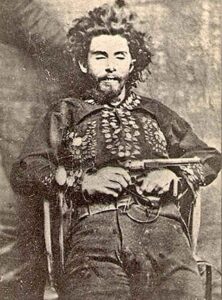 they shouldn’t. The atrocity at the jail was a war crime and should have been punished as such, but I suppose that didn’t justify the murders that followed, because there was no proof that those murdered were involved in any way.
they shouldn’t. The atrocity at the jail was a war crime and should have been punished as such, but I suppose that didn’t justify the murders that followed, because there was no proof that those murdered were involved in any way.
Union military leaders ordered Lieutenant Colonel Samuel P Cox to kill Anderson and provided him with a group of experienced soldiers. A local woman saw Anderson soon after he left Glasgow and told Cox where he was. On October 26, 1864, Cox pursued Anderson’s group with 150 men and engaged them in a battle called the Skirmish at Albany, Missouri. Anderson and his men charged the Union forces, killing five or six of them, but turned back under heavy fire. Only Anderson and one other man, the son of a Confederate general, continued to charge after the others had retreated. Anderson was hit by a bullet behind an ear, which most likely killed him instantly. Four other guerrillas were killed in the attack as well. The victory made a hero of Cox and led to his promotion.
 Sometimes, I am amazed at what you can “sell” people. In 1977, one of Elvis Presley’s assistants saw an opportunity when Elvis didn’t finish a glass of water after a concert. The assistant held an auction and sold the few drops of water left in the glass for $455. And then, there was the two golf balls that were sold for $1400. So, what made these golf balls so special…well, they were swallowed by a python. The snake had to have surgery to remove them, and they were sold after. A British artist, after going through a period of depression, during which she simply stayed in bed, decided to sell the ensuing messy bedroom “furnishings,” so she auctioned them off for $150,000 after calling them “My Bed.” And let us not forget that on March 6, 2012, a woman from Nebraska sold a three-year-old McDonald’s Chicken McNugget for $8100 because it resembled George Washington. She was raising the money to send children to summer camp. The auction site apparently eased its rules on selling expired food for the woman, so that she could raise money to support her cause.
Sometimes, I am amazed at what you can “sell” people. In 1977, one of Elvis Presley’s assistants saw an opportunity when Elvis didn’t finish a glass of water after a concert. The assistant held an auction and sold the few drops of water left in the glass for $455. And then, there was the two golf balls that were sold for $1400. So, what made these golf balls so special…well, they were swallowed by a python. The snake had to have surgery to remove them, and they were sold after. A British artist, after going through a period of depression, during which she simply stayed in bed, decided to sell the ensuing messy bedroom “furnishings,” so she auctioned them off for $150,000 after calling them “My Bed.” And let us not forget that on March 6, 2012, a woman from Nebraska sold a three-year-old McDonald’s Chicken McNugget for $8100 because it resembled George Washington. She was raising the money to send children to summer camp. The auction site apparently eased its rules on selling expired food for the woman, so that she could raise money to support her cause.
Granted these items are novelties, and some went for a good cause, but seriously…people will pay good money 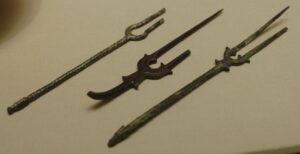 for the strangest things. It actually makes me want to look through my own possessions to see what oddities I might have that would bring in millions of dollars, because apparently, they could sell. You just never know. What is it that makes people decide that they need a few drops of water left in a glass after Elvis drank from the glass, or a McNugget that looks like George Washington, or the many food items that have looked like the Virgin Mary? I suppose that if these things are for a good cause, maybe they are simply donating for the purpose of helping the cause. Or maybe they actually see value in the item or items they are bidding on.
for the strangest things. It actually makes me want to look through my own possessions to see what oddities I might have that would bring in millions of dollars, because apparently, they could sell. You just never know. What is it that makes people decide that they need a few drops of water left in a glass after Elvis drank from the glass, or a McNugget that looks like George Washington, or the many food items that have looked like the Virgin Mary? I suppose that if these things are for a good cause, maybe they are simply donating for the purpose of helping the cause. Or maybe they actually see value in the item or items they are bidding on.
I suppose that in the case of “seeing value” in an item that almost no one else sees value in, I would have to  say…to each his own, but that for the amount some of these items went, there must have been a few people who could see value in something seemingly worthless…at least to me. That said, I decided to go out to an auction site to see what “treasures” I could find. I was somewhat disappointed in that I found no expired food items, or famously worthless celebrity use items. Mostly what I saw were items that did have some value, depending on your need…things like bags full of vintage doll clothes, old pitchers and glassware, belt buckles, automobile emblems, vintage cigarette lighters, coins, and vintage toys. Some of these things could very easily have great value, in that the vintage items could be rare collectables. Nevertheless, I didn’t see anything I couldn’t live without, nor did I find anything that was going for a very high price. I suppose that it would be a rare thing to come across something that cost you nothing, but sold for millions. Still, the idea of selling something for big money isn’t a bad one. It’s just a matter of finding the right item, presenting it to the right audience, and finding yourself feeling very shocked when it sold for the big bucks.
say…to each his own, but that for the amount some of these items went, there must have been a few people who could see value in something seemingly worthless…at least to me. That said, I decided to go out to an auction site to see what “treasures” I could find. I was somewhat disappointed in that I found no expired food items, or famously worthless celebrity use items. Mostly what I saw were items that did have some value, depending on your need…things like bags full of vintage doll clothes, old pitchers and glassware, belt buckles, automobile emblems, vintage cigarette lighters, coins, and vintage toys. Some of these things could very easily have great value, in that the vintage items could be rare collectables. Nevertheless, I didn’t see anything I couldn’t live without, nor did I find anything that was going for a very high price. I suppose that it would be a rare thing to come across something that cost you nothing, but sold for millions. Still, the idea of selling something for big money isn’t a bad one. It’s just a matter of finding the right item, presenting it to the right audience, and finding yourself feeling very shocked when it sold for the big bucks.
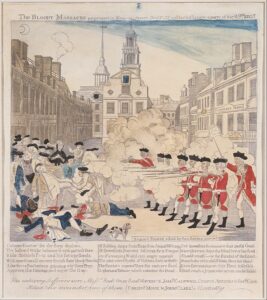 A mob of American colonists gathered at the Customs House in Boston, on the cold, snowy night of March 5, 1770. They called themselves Patriots, and they were there to protest the occupation of their city by British troops, who were sent to Boston in 1768 to enforce unpopular taxation measures passed by a British parliament that lacked American representation. I suppose it is possible that the colonists would have agreed to increase their taxes in an effort to help pay for the Seven-Year War, but the reality is that they were not asked…they were told, and it was to be forced upon them. They were not going tolerate that…so they would fight.
A mob of American colonists gathered at the Customs House in Boston, on the cold, snowy night of March 5, 1770. They called themselves Patriots, and they were there to protest the occupation of their city by British troops, who were sent to Boston in 1768 to enforce unpopular taxation measures passed by a British parliament that lacked American representation. I suppose it is possible that the colonists would have agreed to increase their taxes in an effort to help pay for the Seven-Year War, but the reality is that they were not asked…they were told, and it was to be forced upon them. They were not going tolerate that…so they would fight.
For their part, the British would also not be moved, and they were prepared to fight. British Captain Thomas Preston, the commanding officer at the Customs House, ordered his men to fix their bayonets and join the guard outside the building. The colonists…somewhat less prepared, responded by throwing snowballs and other objects at the British regulars. As the snowball fight commenced, Private Hugh Montgomery was hit, and not knowing what hit him, he discharged his rifle at the crowd. With that, the other soldiers began firing too, and when the smoke cleared, five colonists were dead or dying. They were Crispus Attucks, Patrick Carr, Samuel Gray, Samuel Maverick and James Caldwell. Three more were injured. Although it is unclear whether Crispus Attucks, an African American, was the first to fall as is commonly believed, the deaths of the five men are regarded by some historians as the first fatalities in the American Revolutionary War. After the massacre, the British soldiers were put on trial for war crimes. Strangely, patriots John Adams and Josiah Quincy agreed  to defend the soldiers in a show of support of the colonial justice system. When the trial ended in December 1770, two of the British soldiers were found guilty of manslaughter. As punishment, their thumbs were branded with an “M” for murder. In my mind, that is such a minor punishment, for what we view as such a major crime. I’m not sure if I think that any of the British soldiers were really guilty of murder, or even manslaughter, because it seems to me that in a moment of panic, the soldier mistakenly thought he was in eminent danger, when in reality, it was simply a snowball. Still, the punishment really didn’t fit the crime for which it was given.
to defend the soldiers in a show of support of the colonial justice system. When the trial ended in December 1770, two of the British soldiers were found guilty of manslaughter. As punishment, their thumbs were branded with an “M” for murder. In my mind, that is such a minor punishment, for what we view as such a major crime. I’m not sure if I think that any of the British soldiers were really guilty of murder, or even manslaughter, because it seems to me that in a moment of panic, the soldier mistakenly thought he was in eminent danger, when in reality, it was simply a snowball. Still, the punishment really didn’t fit the crime for which it was given.
The Stamp Act was called the “Boston Massacre” by the Sons of Liberty, a Patriot group formed in 1765 to oppose it. The “Boston Massacre” was viewed as a battle for American liberty and just cause for the removal of British troops from Boston. Patriot Paul Revere made an engraving of the incident, depicting the British soldiers lining up like an organized army to suppress an idealized representation of the colonist uprising. Copies of the engraving were distributed throughout the colonies. This was to help reinforce negative American sentiments about British rule. The colonists needed as many in their ranks to be onboard with the battle, and so any depiction of the British as cruel slave masters would help.
The American Revolution officially began in April of 1775, when British troops from Boston fought with American militiamen at the battles of Lexington and Concord. The British troops were under orders to capture 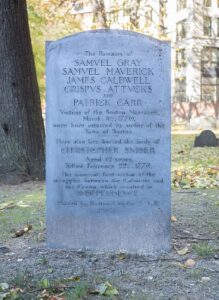 Patriot leaders Samuel Adams and John Hancock in Lexington and to confiscate the Patriot arsenal at Concord. Unfortunately for them, the Patriots were several steps ahead of them, and neither of the missions were accomplished because Paul Revere and William Dawes rode ahead of the British to warn Adams and Hancock and to rouse the Patriot minutemen.
Patriot leaders Samuel Adams and John Hancock in Lexington and to confiscate the Patriot arsenal at Concord. Unfortunately for them, the Patriots were several steps ahead of them, and neither of the missions were accomplished because Paul Revere and William Dawes rode ahead of the British to warn Adams and Hancock and to rouse the Patriot minutemen.
The British forces were forced to evacuate Boston eleven months later, in March 1776, following American General George Washington’s successful placement of fortifications and cannons on Dorchester Heights. Oddly the eight-year British occupation of Boston ended with a bloodless liberation of the city. General Washington, commander of the Continental Army, was presented with the first medal ever awarded by the Continental Congress for the victory. It would be more than five years before the Revolutionary War came to an end with British General Charles Cornwallis’ surrender to Washington at Yorktown, Virginia.

 My sister-in-law, Rachel Schulenberg was just about 4 months older than my oldest daughter, Corrie, so she was like a sister-in-law and a daughter too. The things she liked were similar to things my daughters, Corrie Petersen and Amy Royce liked. It makes sense that it would be that way, because my brother-in-law, Ron Schulenberg was just 7 years old when my husband, Bob and I got married. They were in the generation of our kids. I guess that is part of what makes it so hard to believe that Rachel has been living in Heaven for a little over a year now. She was just too young to have a fatal stroke. It just shouldn’t happen that way.
My sister-in-law, Rachel Schulenberg was just about 4 months older than my oldest daughter, Corrie, so she was like a sister-in-law and a daughter too. The things she liked were similar to things my daughters, Corrie Petersen and Amy Royce liked. It makes sense that it would be that way, because my brother-in-law, Ron Schulenberg was just 7 years old when my husband, Bob and I got married. They were in the generation of our kids. I guess that is part of what makes it so hard to believe that Rachel has been living in Heaven for a little over a year now. She was just too young to have a fatal stroke. It just shouldn’t happen that way.
Rachel was good friends with my nieces, Machelle Moore and Susan Griffith, and it was through them that she was introduced to their Uncle Ron. It was a match made in Heaven, and they were married over 11 years when she passed away. They were so happy, and I know their marriage would have continued well into their golden years if she hadn’t left us too soon. Besides Ron, Rachel also left behind daughter, Cassie Franklin and her 
 children Lucas and Zoey; son, Riley Birky his fiancée, Sierah Martin, her son, Jace and their little baby that is coming in this August; and Tucker Schulenberg, her youngest, who was adopted by Ron in 2019, so she knew he would be ok. Rachel was a wonderful mother and grandmother, who loved her children and grandchildren so much, and the perfect wife for Ron…his soulmate.
children Lucas and Zoey; son, Riley Birky his fiancée, Sierah Martin, her son, Jace and their little baby that is coming in this August; and Tucker Schulenberg, her youngest, who was adopted by Ron in 2019, so she knew he would be ok. Rachel was a wonderful mother and grandmother, who loved her children and grandchildren so much, and the perfect wife for Ron…his soulmate.
Rachel was a vibrant person, who loved the Lord. She had worked in the office of her church in Powell, Wyoming before she married my brother-in-law, and moved to Casper. She loved telling people about Jesus and seeing people get saved. She wanted to make sure that everyone she could win for the Lord, she did win for 
 the Lord. Rachel was quick to pray for anyone who needed prayer, even if they didn’t ask her for prayer, she prayer for them. There are many people out there who have received answered prayer because of Rachel…I have no doubt. Rachel was a wonderful person, Christian, and friend to many people, and she has been greatly missed by all of us over the past year. Today would have been Rachel’s 47th birthday. Happy birthday in Heaven, Rachel. We love and miss you very much.
the Lord. Rachel was quick to pray for anyone who needed prayer, even if they didn’t ask her for prayer, she prayer for them. There are many people out there who have received answered prayer because of Rachel…I have no doubt. Rachel was a wonderful person, Christian, and friend to many people, and she has been greatly missed by all of us over the past year. Today would have been Rachel’s 47th birthday. Happy birthday in Heaven, Rachel. We love and miss you very much.

 My grandniece, Kaytlyn Griffith has shocked me with how much she has changed this year. I saw a picture of her with her family, and she is almost as tall as her older sister, Jala Satterwhite. What??? When did that happen? When I think of Kaytlyn, an 8-year-old girl comes to mind, but that was six years ago, so I need to catch up. The funny thing about kids is that for some reason, when they move from elementary school to middle school, suddenly this older kid emerges where a child once was, it seems.
My grandniece, Kaytlyn Griffith has shocked me with how much she has changed this year. I saw a picture of her with her family, and she is almost as tall as her older sister, Jala Satterwhite. What??? When did that happen? When I think of Kaytlyn, an 8-year-old girl comes to mind, but that was six years ago, so I need to catch up. The funny thing about kids is that for some reason, when they move from elementary school to middle school, suddenly this older kid emerges where a child once was, it seems.
Much has changed for Kaytlyn and her family with year, because her older sister moved out after graduation, leaving Kaytlyn the only child at home. That has been a strange change for the whole family. While Jala has her own place now, she and Kaytlyn have actually gotten a little closer now. Their mom, Susan Griffith told me that they even hug now, and that was totally tabu before, and they never hugged before. Even going camping is very different these days. It has usually been Kaytlyn’s mom and dad, Josh and Susan, and her sister, Jala, but this past year was just Kaytlyn and her parents. Jala was working, and in general, doing her own thing. One thing about being the only child at home, is that you get your choice of bedrooms, and so often the oldest child has had the “best” bedroom, but now, Kaytlyn has decided that Jala’s room was fair game, so she moved in there, and is feeling very privileged to have the best.
Kaytlyn is more than just a good student. She is an Honor Roll student. She loves school and has worked very hard at the goal of carrying a 4.0 GPA. She is extremely close to that goal now. She loves math and getting 100% on a math test is pretty common for this smart girl!! Kaytlyn was also a Covid middle schooler, in that she started middle school (6th grade) in the fall of 2019. Of course, we all know what happened next. The first few months were ok, but by Spring Break, Covid-19 had changed everything about school as we all knew it. The whole middle school experience was different than any of us ever could have imagined for that class. Kaytlyn went to one dance in 6th grade before all this started, and then her class didn’t have another dance until a few weeks ago. So, since 2019, she has only gone to two dances. It is sad, because Kaytlyn and her class have missed out on so much.
One consolation…for Kaytlyn anyway, is that because her family lives far enough out in the country, she can 
 qualify for a “Hardship License.” For those who don’t know, that is for certain people who live far enough in the country that it puts a hard ship on their parents, so the state will let them start driving a year before the other kids. While middle school was sort of a “bust,” Kaytlyn will be starting high school in the Fall…and she will be driving. We can only hope that she has a better experience with high school than she did with middle school. Kaytlyn has worked so hard, and she deserves a great year. Today is Kaytlyn’s 14th birthday. Happy birthday Kaytlyn!! Have a great day!! we love you!!
qualify for a “Hardship License.” For those who don’t know, that is for certain people who live far enough in the country that it puts a hard ship on their parents, so the state will let them start driving a year before the other kids. While middle school was sort of a “bust,” Kaytlyn will be starting high school in the Fall…and she will be driving. We can only hope that she has a better experience with high school than she did with middle school. Kaytlyn has worked so hard, and she deserves a great year. Today is Kaytlyn’s 14th birthday. Happy birthday Kaytlyn!! Have a great day!! we love you!!
 Many people believe that there was no good reason for the war in Vietnam. It seemed like a war we were not going to be allowed to win, and many thought it should have been one we just stayed out of. Vietnam became a French colony in 1877 with the founding of French Indochina, which included Tonkin, Annam, Cochin China and Cambodia…Laos was added in 1893. The French lost control of their colony briefly during World War II, when Japanese troops occupied Vietnam.
Many people believe that there was no good reason for the war in Vietnam. It seemed like a war we were not going to be allowed to win, and many thought it should have been one we just stayed out of. Vietnam became a French colony in 1877 with the founding of French Indochina, which included Tonkin, Annam, Cochin China and Cambodia…Laos was added in 1893. The French lost control of their colony briefly during World War II, when Japanese troops occupied Vietnam.
After the war, Japan and France continued to fight over Vietnam. Ho Chi Minh, a revolutionary leader inspired by Lenin’s Bolshevik Revolution began forming an independence movement. He established the League for the Independence of Vietnam, better known as the Viet Minh, in May of 1941. On September 2, 1945, he declared Vietnam’s independence from France, just hours after Japan’s surrender in World War II. When the French rejected his plan, the Viet Minh resorted to guerilla warfare to fight for an independent Vietnam.
One of the most well-known campaigns of the Vietnam War was codenamed Operation Rolling Thunder. It was an American bombing campaign in which US military aircraft attacked targets throughout North Vietnam from March 1965 to October 1968. This operation was intended to put military pressure on North Vietnam’s communist leaders, thereby reducing their capacity to wage war against the US-supported government of South Vietnam. With that, operation American began its involvement began, not only its assault on North Vietnamese territory, but the expansion of US involvement in the Vietnam War.
By the 1950s, the US military began providing equipment and advisors to help the government of South Vietnam to resist a communist takeover by North Vietnam and its South Vietnam-based allies, the Viet Cong guerrilla fighters. The American military initiated limited air operations within South Vietnam in 1962, in an effort to offer air support to South Vietnamese army forces, destroy suspected Viet Cong bases, and spray herbicides such as Agent Orange to eliminate jungle cover. It was an ugly time for anyone in the area. In August 1964, President Lyndon B Johnson expanded American air operations, when he authorized retaliatory air strikes against North Vietnam following a reported attack on US warships in the Gulf of Tonkin. Later that year, Johnson approved  limited bombing raids on the Ho Chi Minh Trail, a network of pathways that connected North Vietnam and South Vietnam by way of neighboring Laos and Cambodia. The president’s goal was to disrupt the flow of manpower and supplies from North Vietnam to its Viet Cong allies. Nothing the United States tried really worked to remove the tensions in the area, and so in 1963, the United States withdrew from Vietnam. Unfortunately, they left behind bombs and land mines from Operation Rolling Thunder and other bombing campaigns of the Vietnam War. By some estimates, those bombs and land mines have killed or injured tens of thousands of Vietnamese people since the United States withdrew its combat troops in 1973.
limited bombing raids on the Ho Chi Minh Trail, a network of pathways that connected North Vietnam and South Vietnam by way of neighboring Laos and Cambodia. The president’s goal was to disrupt the flow of manpower and supplies from North Vietnam to its Viet Cong allies. Nothing the United States tried really worked to remove the tensions in the area, and so in 1963, the United States withdrew from Vietnam. Unfortunately, they left behind bombs and land mines from Operation Rolling Thunder and other bombing campaigns of the Vietnam War. By some estimates, those bombs and land mines have killed or injured tens of thousands of Vietnamese people since the United States withdrew its combat troops in 1973.

